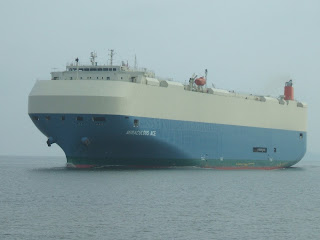Hell Gate is where the strong currents of the East River meet the waters of the Harlem River near Mill Rock. Its reputation for strong, reversing currents (4 to 5 knots), large waves, and heavy commercial traffic is well-deserved. Timing your safest, least harrowing passage through the area is dependent on the tidal currents. After consulting Eldridge Tide and Pilot Book, Frank determined that an early departure from LHYC would be prudent.
Lazy W’s engines were purring; by 6AM we had thrown off the lines and were ready to go. While I stowed the fenders and tidied up the lines, Frank put Lazy W in reverse. No movement! I wondered if we had lost reverse gear. Frank wondered if we had forgotten to undo all the lines. Neither one of us was correct. Lazy W’s bow was sitting in mud! Even though there was 40+ feet of water in the Hudson River , there was less than 4 feet in the marina. We tied up again waiting for the incoming tide to release the bow. A half hour later the bow was swaying in the water so we made a second attempt to leave. We extricated Lazy W from the slip and dredged our way through the fairway to the Hudson River .
Numerous NY Waterway taxis were already traversing the Hudson and speeding up and down the East River . It was a gorgeous morning for a cruise past the South Street
...and under the Brooklyn Bridge
...and up the East River passing the Chrysler Building
Our timing through Hell Gate was just about perfect. There was no on-coming commercial traffic to intimidate us and the current was running in our favor. Before long we were approaching the Throgs Neck Bridge , the demarcation line between the East River and the Long Island Sound. Under the bridge at Fort Schuyler is Frank’s alma mater, SUNY Maritime College
After dinner one evening we had some unexpected visitors to the boat.
The heat wave gripping the eastern seaboard was getting a bit unbearable. Lazy W has air conditioning but in order to use it at anchor we need to run the generator. Since there is little insulation on Lazy W to keep the cool air in and the heat out, as soon as the generator and A/C are turned off the temperature aboard begins its upward climb. We needed to spend some time in a marina where we could plug in and run the A/C 24/7. Brewer’s Yacht Yard in Glen Cove
On the hottest day of the record breaking heat wave we visited Sagamore Hill, the un-air-conditioned home of Theodore Roosevelt. TR, our 26th president, was born in New York City United States Oyster Bay , became the “Summer White House” from 1902-1909, hosting many leaders and dignitaries from around the world.
An avid sportsman and hunter, Theodore Roosevelt was also a staunch conservationist. During his presidential term he doubled the number of national parks, set aside 100 million acres of national forests, and signed into law the Antiquities Act which enabled him and his successors to proclaim historic landmarks and structures as national monuments.
The stuffed bear of our childhood that we all know as Teddy Bear was named after Theodore Roosevelt. The story goes that in 1902 he refused to shoot a sickly bear on a hunting trip. That moment was immortalized in political cartoons. The founders of the Ideal Toy Corporation seized this as a great marketing opportunity and asked Roosevelt ’s permission to give his name to a new stuffed bear that they were getting ready to sell. The rest is history...
At the turn of the last century, Long Island ’s north shore was home to such extravagant wealth and style it became known as the “Gold Coast.” America Long Island in the early decades of the 20th century. Although many of these homes proved to be too large and inefficient to maintain and were demolished, some still exist today, though in another capacity – as a college, a museum, a planetarium, a religious institute, a conference center or state and county parks.
Vanderbilt’s 24-room, Spanish Revival mansion was built in stages between 1910 and 1936 and reflects the eclectic tastes and collecting interests of Mr. Vanderbilt. You can’t name your estate ‘Eagle’s Nest’ and not have some eagles present. The two large eagles flanking the entrance to the estate were taken from the original Grand Central Station. Just beyond is a grassy area that has columns taken from the ancient ruins of Carthage
The shopping malls of the wealthy were the monasteries and cathedrals of Europe . As was typical of many of the grand estates of the Gold Coast, the Vanderbilt mansion is filled with fixtures, tapestries, art works and antiquities from around the world. There is an excess of taxidermy throughout the house with an entire wing dedicated to birds, butterflies, and large land animals. It is hard to believe that while the country was in the throes of the Great Depression the Vanderbilts were having bath tubs carved from single slabs of marble and living in such grand surroundings! Such uninhibited wealth and opulence of this era have been forever immortalized in F. Scott Fitzgerald’s book, The Great Gatsby.





































